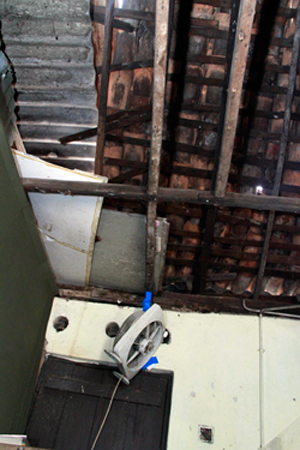Ubiquitous public officials
View(s):
A GN office which was inaugurated as a model GN office in Kirulapone.
Residents wait outside a ramshackle old building, the door is padlocked (there is no proper keyhole). As the government official, the most important in the area, arrives and opens the padlock, residents trickle in one by one, causing the official to tell them to wait in line outside, in the hot sun, as the office doesn’t have enough space. Inside, the official sits at an old table filled with files and begins dealing with the public.
The official is the Grama Niladhari (GN), formerly known as the headman who was considered the most powerful and influential in the village. Since the mid-1960s, when the change occurred, that recognition has gone through the window and the GN is regarded as yet another state official, though his duties have a huge impact on the lives of everyone in the village, town or city. Everyone needs him – the rich, the powerful and the middle and lower income group residents. There is no class discrimination.
Of course, there are allegations of corruption against some GNs but for the moment we are concentrating on their working conditions which sorely need to improve if they are to provide an efficient service.
Given that he performs an important role in the area, why is the GN given a raw deal, having to work in derelict surroundings with no proper ventilation or lighting? The roof needs repair and my gut feeling is that it must be leaking during the rains.

An almost collapsing roof of a GN office near Colombo.
As I pondered over these issues, my attention was drawn to the trio who had gathered under the margosa tree, sipping tea while they talked. Today’s conversation was ironically about going to the GN office to be registered for the COVID-19 vaccination.
“Mama polime hitiya peya dekakatath wediya (I had to stay in the queue for over two hours),” said Kussi Amma Sera about her visit.
“Mama kalinma giya, 6.30ta withara. Grama Niladhari ave 8.45ta. Polimewisi-denek withara hitiya eya avith officiya arinakota (I went early at around 6.30 a.m. and the Grama Niladhari arrived at 8.45 a.m. There were around 20 others in the queue by the time he opened the office),” noted Serapina.
Adding to the conversation, Mabel Rasthiyadu said: “Ape gamey Grama Niladharige officiya Colombo thiyena officiya wediya ida-kada thiyenawa (The Grama Niladhari in my village has a better office which is more spacious than the ones in Colombo).”
Today, the GN offices are busy as people are crowding there to obtain tokens for the COVID-19 vaccinations.
According to official data, the GN divisions come under the Ministry of Home Affairs. There are 14,022 GN divisions under 332 Divisional Secretary Divisions all over the island. Their duties are numerous, from issuing letters to get a national ID, a character certificate to obtain a job, resident certificates and distributing and collecting the voters’ list (a very important function) for election use, the GN is the most important official in the area. He is also responsible for keeping track of criminal activity in his area (is he geared for this?). He is also perceived as a Peace Officer. One of the most prominent citizens in the country who started life as a Grama Niladhari in 1976 is former President Maithripala Sirisena who served in this post for two years.
While I walked to the kitchen to fetch my first cup of tea for the day, the phone rang. It was my jolly-mood economist friend, Sammiya (short for Samson).
“Hello… hello, what’s news,” I said. “Nothing really, just called to find out about life during the pandemic,” he replied, cheerfully. “Well, good that you called because I am writing about Grama Niladharis and the appalling conditions they are working in which doesn’t provide any motivation to do a decent job,” I said.
 Sammiya then related a story how many years ago, the work ethic of staff at the Bank of Ceylon changed dramatically when their environment was made more pleasant and comfortable. “I can give you at least two examples of the bank branches at Bambalapitiya and Nugegoda where staff received modern tables, well upholstered swivel chairs, good air conditioning and the service standards improved tremendously. The change was such that it was like walking into the branch of a foreign bank with swanky new furniture. The staff was also more pleasant and courteous – something that was unexpected from a state bank,” he said.
Sammiya then related a story how many years ago, the work ethic of staff at the Bank of Ceylon changed dramatically when their environment was made more pleasant and comfortable. “I can give you at least two examples of the bank branches at Bambalapitiya and Nugegoda where staff received modern tables, well upholstered swivel chairs, good air conditioning and the service standards improved tremendously. The change was such that it was like walking into the branch of a foreign bank with swanky new furniture. The staff was also more pleasant and courteous – something that was unexpected from a state bank,” he said.
“You’re right, I have experienced the same courtesy and service standards at Bank of Ceylon branches,” I said, adding that if state officials are provided decent office space it helps not only to motivate them but also to be courteous to the public; after all these officials are ‘servants’ of the people and paid from taxes imposed on the public.
So, why isn’t the government providing the necessary facilities to GNs when they are the most important officials in villages or towns? That’s a question that has to be answered by every government in power, present and past, and goes to show the importance particularly in budget allocations that the regime attaches to the role of the GN.
On the contrary, the government is spending millions on state buildings housing centralized government institutions when much of this budgetary allocation could be channelled to the upkeep of GN divisions. For example, the other day there was an announcement by prominent contractor MAGA which has been entrusted with building ‘Sethsiripaya Stage III’, the third phase of the government’s administration hub in Battaramulla. This is a 25-storey modern office building with a floor area of over 1.3 million square feet – making it the largest public sector building and the largest office complex in the country.
Once completed, the complex is expected to cater to over 7,500 occupants. It is valued at Rs. 16.7 billion and funded by the Urban Development Authority. Why not channel part of these funds to improve the office space of GNs?
As Kussi Amma Sera breezed in with my second mug of tea, she asked: “Grama Niladhariwa hamu wunada (Did you meet the Grama Niladhari)?”
I nodded in agreement and wished this sector of Sri Lanka’s public service will get the attention it deserves by initially providing comfortable offices to GNs to carry out their numerous and important work.
(PS. For the first time this column carries pictures showing a dilapidated GN office and a better one).



